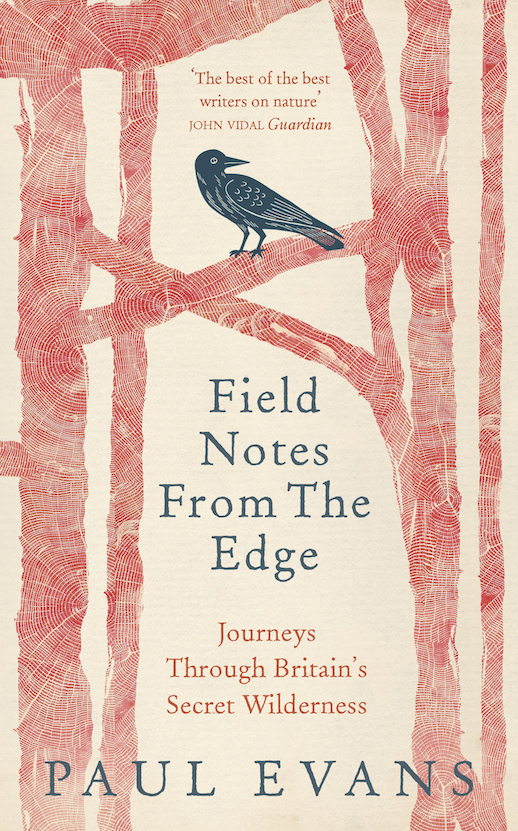Field Notes from the Edge: Journeys through Britain’s Secret Wilderness, by Paul Evans
Ebury Press, hardback, 272 pages. Out now
Book review by Neil Sentance
For the past month we’ve been left in charge of my mother-in-law’s young dog, a lively whippet-poodle cross, while she has been back in the States at her college reunion. I’ve always been immune to the odiferous charm of hounds, but the opportunity for daily walking is always welcome.
Most days we turn out of the garden of the stone cottage we’re staying in for the summer and walk up the quarry lane to the nature reserve, a few acres of mixed woodland on a limestone crag above the village. Mature beech trees tilt in to form a cool holloway. We tramp past the lichenous and mossy limekiln, where the forest marble for the village houses, barns and field boundaries was once worked. Nature, never still, has re-colonised this ex-industrial place, a thorny green veneer covering the aperture to the burning chamber, now home to badgers and oversummering swifts, ignored by the snout-led dog. I stop to talk to a neighbour who’s been replacing his dilapidated fences, digging down into the foundations of an ancient dry stone wall to plant his posts. Moving on we pass an open sheep field, sloping away towards some broken glasshouses. In the autumn I like to watch lapwings here, recalling a childhood passion as a keen member of the Young Ornithologists’ Club. They totter over the waving cilia of windblown pastures, and gather in ever smaller groups, slight deceits in the longer grasses.
We see a young roe deer edge out of the tree cover. He stands stock-still, eyes never leaving us though we are 300 yards away. The dog pricks his ears. We walk on and when I next look, a few seconds later, the deer has melted away. We reach the ridge and walk along the rutted farmways. Beyond, the land falls away towards the coast and the churning blue of Lyme Bay. We turn inland along the rough, rubbly Milvers Lane, a slow warp round tiers of ancient strip lynchets. Past a thin trickling bourn, a herd of about twenty young bullocks slope off up the hill, but as we come down by the hedgerow they reappear, in bulk, as in a Ted Hughes tale, and start to rumble down the escarpment towards us. The dog, a true scaredy-cat, cowers behind me, his wet nose peeking out between my calves. I have a few seconds to recall the fate of my great-grandfather, Frederick William Paley, tossed and killed by a bull in August 1946 (something I have written of before on this site, and no doubt will again), forever seared into our family mythos. Some atavistic farm boy reflex has me hollering, ‘whoa, whoa’ and waving arms, panicked. It works. The lead bullocks skid and pull up, the ones behind piling into them, cartoon-style. They lumber off to the next field. The dog and I hightail to the lane.
Perhaps this episode is an example of ‘ecophobia’, our fundamental disconnect with Wild (or in this case, semi-wild) Nature, a central tenet of Paul Evans’s book Field Notes from the Edge: Journeys through Britain’s Secret Wilderness. Mr Evans builds his analysis on the close observation and Macfarlane-sharp precision of description that are his stock-in-trade as Country Diarist for The Guardian. It is the liminal spaces, those ‘betwixt and between’, the secret wilderness at the titular ‘Edge’, that are his principal concerns in this book. The ‘Edge’ is multifaceted here of course: not merely the marginal or transitional places, such as ex-industrial sites like the limekiln; but also in the notion that all landscapes are mutable spaces, change hastened by anthropogenic forces. The Edge is also Wenlock Edge, the limestone escarpment in Shropshire that is Evans’s homeland, and its particular spirit of place; and the ‘bastard countryside’ or ‘drosscape’, where the deadening hand of industry and agribusiness have produced an ugly zone, a compromised biome. And it is the edge of calamity, the mass ecocide that humanity seems to be dashing towards.
But this book is full also of the metaphysical and the numinous, lit with fulgent moments of phosphorescence. Each chapter visits a particular peripheral landscape – Ridge, Strand, Isle, Plot – and details the half-hidden flora and fauna living there. Interleaved are sparkling vignettes of folkloric tales, archaeology and anthropology, art and literature, all the bricks and mortar of our complex relationship with the natural world (of which we are a part and from which we are apart). The style is lyrical but succinct and lucent (nature-writing is not always thus). The portentous chapter on ‘Flood’ is worth the book’s cover price alone: reflections on the flooding of Tewkesbury, the fate of a buoyed mirror ball on the deluged River Severn, the significance of waterfowl, especially swans, in early English poetry, herons ‘stalking the shore like a knife on stilts’, the fantastical soundings of water boatmen on rivers in Ireland made with recordist Tom Lawrence (in the style of Chris Watson of this parish). And all conveyed in a skilful torrent of words – it brought to mind Edward Abbey in his book Desert Solitaire on the doomed branch of the Colorado River before the Glen Canyon dam construction. Field Notes from the Edge is a strange, wonderful, maudlin, meditative and romantic book. A book of great sensorial qualities, deeply stratified. Some of its streams are percolating yet. I urge it upon you.
My mother-in-law’s dog has gone home today, and will soon be back to romping along the barren bounds of Clapham Common. I’ll go back to searching for lapwings and avoiding inquisitive cattle.
Field Notes from the Edge: Journeys through Britain’s Secret Wilderness is available here
Neil Sentance is the author of Water and Sky, a Caught by the River publication, available here.
